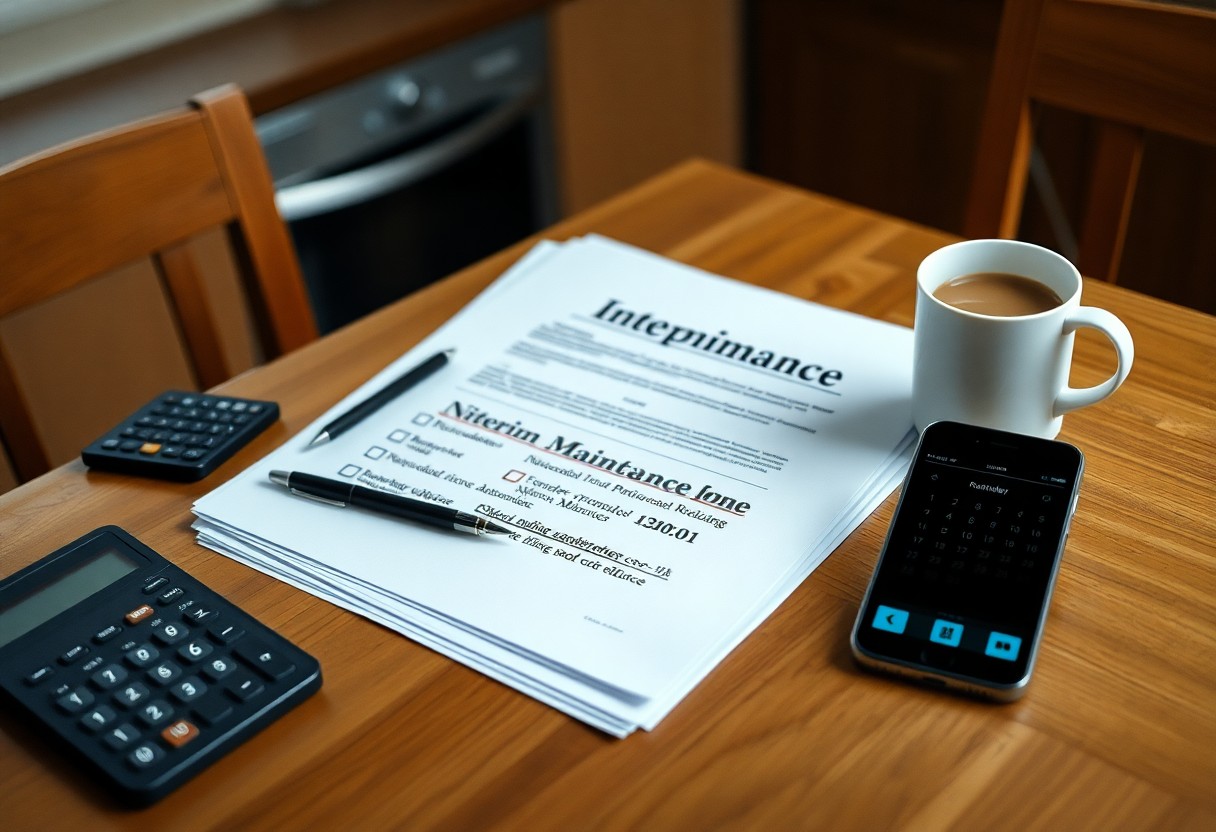Most individuals going through a divorce face financial uncertainty, making it crucial for you to understand how to apply for interim maintenance. This temporary financial support can help cover your living expenses while your divorce proceedings unfold. In this post, you’ll learn the steps to effectively submit your application and the important documents you need, which can significantly impact the outcome. By following this guide, you can ensure that your needs are met during this challenging time, setting a positive course for your future.

Key Takeaways:
- Understand the purpose of interim maintenance, which is to support one spouse financially during the divorce process.
- Gather financial documentation, including income, expenses, and any debts, to present a clear picture of your financial needs.
- Consult a family law attorney to guide you through the application process and ensure all legal requirements are met.
- File the appropriate motion for interim maintenance with the court, including necessary forms and supporting documentation.
- Prepare for a hearing where both parties can present their financial circumstances to the judge.
- Be aware of your state’s specific laws and guidelines regarding interim maintenance eligibility and the factors considered by the court.
- Maintain open communication with your attorney throughout the process to stay informed and make adjustments as necessary.

Assessing Your Financial Status
Before pursuing interim maintenance, thoroughly assess your financial status. Gather information on your income, expenses, and overall financial obligations. This step will empower you to present a comprehensive picture of your financial needs during divorce proceedings. Understanding where you stand financially helps to justify your request for interim maintenance, ensuring you provide accurate and relevant details to the court.
Documenting Income and Expenses
Compile all sources of income, including salary, bonuses, rental income, and any other earnings. Alongside this, list your monthly expenses, such as mortgage or rent, groceries, utilities, and insurance. Having a clear record of your finances allows you to paint a vivid picture of your current economic situation, aiding the court in understanding your need for interim support.
Understanding Your Financial Needs
Assessing your financial needs requires a deep investigate both your short-term and long-term goals. Consider immediate expenses for housing, food, and child care, while also accounting for future obligations like education or unforeseen medical costs. Establishing a comprehensive understanding of your financial obligations will help articulate your needs effectively, ensuring you seek an amount that genuinely reflects your lifestyle and requirements.
Clarifying your financial needs involves calculating the total amount required to maintain your current standard of living. If you anticipate changes in your life during the divorce, such as increased costs due to temporary housing or childcare, include these projections in your analysis. For example, if you’re a parent expecting changes in child support, factor in those potential adjustments. Make a detailed list using realistic figures while considering both current expenses and any potential future costs that might arise as your divorce progresses. This careful assessment will strengthen your request for interim maintenance, showing the court you are proactive and informed about your financial situation.
Navigating Legal Grounds for Interim Maintenance
Understanding the legal grounds for interim maintenance is important for a successful application. This financial support addresses immediate economic disparities during the divorce proceedings, allowing both parties to maintain a reasonable standard of living while the divorce is finalized. Courts typically evaluate several factors, including the duration of the marriage, financial need, and the ability of the other spouse to pay. Having clear documentation of your financial requirements and supporting evidence can significantly bolster your request.
Identifying Eligibility Criteria
Eligibility for interim maintenance often hinges on specific criteria. Typically, you must demonstrate financial need while your spouse has the ability to provide support. Factors such as your standard of living during the marriage, each spouse’s income, and their respective contributions to the marital finances will be considered. Thorough documentation of expenses and income is also vital in illustrating your case effectively.
Recognizing State-Specific Regulations
State laws regarding interim maintenance can widely vary, impacting your application process. Some states may have prescribed formulas for calculating maintenance amounts, while others adhere to discretionary standards left to the discretion of the judge. Additionally, certain jurisdictions require evidence showing that you cannot meet your basic needs without support, while others offer more leniency in establishing eligibility.
For instance, in California, the court utilizes a specific formula based on incomes and time spent in marriage when determining spousal support, whereas New York grants judges greater leeway in discretion. This means that understanding the statutes specific to your state is fundamental, as local legal frameworks can significantly influence both the amount and duration of support granted. Be sure to familiarize yourself with these regulations or seek the assistance of a local attorney to navigate accordingly.
Gathering Necessary Documentation
To successfully apply for interim maintenance during your divorce, you must gather comprehensive documentation that outlines your financial situation and needs. Organizing this data allows the court to evaluate your request and determine a fair maintenance amount while you navigate this challenging time.
Key Papers to Collect
Assemble critical documents such as your income tax returns, bank statements, pay stubs, and any proof of recurring expenses like rent, utilities, and child care. Additionally, include documents that reflect your current financial needs and obligations. Having these papers available offers a clearer picture of your economic situation.
Tips for Organizing Your Case
Creating a structured filing system can be beneficial in managing your case. Use folders or digital files to categorize your documents based on types, such as income, expenses, and legal paperwork. You might also consider a timeline of significant financial events during the marriage and how they impact your current needs. Perceiving this organization as vital will aid in presenting your case to the court effectively.
- Structured filing system for financial documents.
- Categorizing documents into income and expenses.
- Creating a timeline of financial events during the marriage.
- Presenting your case effectively to the court.
Utilizing digital tools or apps can assist in organizing your case further. Consider using spreadsheets to track expenses and income, which may provide visual aids to support your claims. Sorting through all financial papers using labeling techniques can streamline the process. Perceiving this level of preparation as imperative will make presenting your case more straightforward and convincing.
- Using digital tools like spreadsheets for clarity.
- Labeling techniques for easy identification.
- Making the process more straightforward.
- Convincing presentation of your claims in court.
Crafting Your Request for Interim Maintenance
Formulating your request for interim maintenance requires a delicate balance of clarity and detail. You need to articulate your needs comprehensively while ensuring your petition resonates with the court’s expectations. Providing accurate financial documentation alongside a clear explanation of your current situation will bolster your argument. Aim to present a well-rounded picture of your financial needs, encompassing important living expenses, any existing obligations, and the potential impact of the divorce on your financial stability.
Structuring a Compelling Petition
Your petition should follow a logical structure, beginning with a brief introduction of your situation and moving into detailed explanations of your financial needs. Clearly outline your expenses, income, and any changes brought about by the divorce. Include statements on why interim maintenance is necessary for maintaining your standard of living, supported by documented evidence. An organized approach not only aids comprehension but also strengthens the credibility of your case.
Common Pitfalls to Avoid
Avoiding certain missteps can significantly improve your chances of receiving interim maintenance. Failing to provide adequate financial documentation, making exaggerated claims, or poorly articulating your situation can lead to your request being denied. Keep your petition focused and factual—stay away from emotional appeals that may detract from the core issues.
The court expects your petition to be grounded in reality; overinflating your needs or ignoring specific requirements can cause your request to falter. It’s important to back up every claim with tangible evidence, such as bank statements, bills, and receipts. Organizing your evidence logically enhances your argument and reflects your credibility. Always remember to check local court rules as they may dictate specific formats or requirements that, if overlooked, could weaken your case.

Preparing for Court Proceedings
Preparation for court proceedings involves organizing your documentation, understanding courtroom protocols, and anticipating the questions you may face. You’ll want to review your collected materials thoroughly while ensuring all necessary paperwork is completed correctly. Familiarize yourself with basic court etiquette, like addressing the judge appropriately and demonstrating respect to everyone involved. Arriving early to court will provide a buffer for any unexpected delays and allow you to settle in before your hearing.
What to Expect During Hearings
During the hearing, both you and your spouse will present your cases regarding interim maintenance. Expect to provide evidence and answer questions posed by the judge. Typically, the hearing won’t take long, but the judge may require additional information before making a decision. Understanding this process helps reduce unexpected stress and anxiety.
Effective Communication with Your Attorney
Engaging in open and honest communication with your attorney is vital for navigating the interim maintenance process successfully. Clearly outlining your financial situation and goals will enable your lawyer to build a strong case on your behalf. Regularly updating them about any changes, concerns, or additional documentation ensures that any developing complexities are swiftly addressed.
Your attorney relies on your insights and experiences to fully understand the nuances of your situation. Provide detailed explanations of your finances, including income, expenses, and your spouse’s financial status, without holding back. Be proactive in giving updates about any changes or issues that could affect your case. Ongoing discussions not only help your lawyer craft a persuasive argument but also keep you aligned on your goals throughout the proceedings.
Final Words
Following this guide, you now understand the steps to apply for interim maintenance during your divorce. Make sure to gather all necessary documentation and present a clear case to substantiate your financial needs. Consult with a legal professional to navigate the process effectively and ensure your rights are protected. By taking these steps, you can secure the support you need during this challenging time, allowing you to focus on your emotional well-being and the transition ahead.
FAQ: How to Apply for Interim Maintenance During Divorce
Q: What is interim maintenance during a divorce?
A: Interim maintenance refers to financial support provided by one spouse to the other during the divorce proceedings. It is designed to ensure that the dependent spouse has adequate financial resources to meet their daily living expenses while the divorce is being finalized.
Q: Who is eligible to apply for interim maintenance?
A: Generally, the spouse who lacks sufficient financial means to support themselves during the divorce can apply for interim maintenance. Eligibility may include factors such as income disparity, the length of the marriage, and the dependent spouse’s financial needs.
Q: How do I file for interim maintenance?
A: To file for interim maintenance, you typically need to submit a motion to the court along with any necessary documentation that supports your claim, including income statements and details of your expenses. It’s advisable to consult with an attorney to ensure proper filing and documentation.
Q: What documents are required to support my application for interim maintenance?
A: Common documents required include proof of income, bank statements, tax returns, and documentation of monthly expenses. You may also need evidence of your spouse’s income and financial status to substantiate your claim.
Q: How does the court determine the amount of interim maintenance?
A: The court considers various factors when determining the amount of interim maintenance, including the financial needs of the requesting spouse, the paying spouse’s ability to pay, the standard of living during the marriage, and the length of the marriage. Each case is assessed on its individual merits.
Q: Can interim maintenance be modified later during the divorce process?
A: Yes, interim maintenance can potentially be modified based on changes in circumstances. If there is a significant change in income or other financial situations for either spouse, a request can be made to the court to adjust the amount of support provided.
Q: How long does interim maintenance continue?
A: Interim maintenance typically continues until the divorce is finalized or until the court orders an alternative arrangement. It is meant to provide support during the pendency of the divorce process, at which point permanent maintenance may be determined based on the final divorce settlement.
